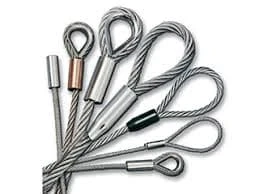In the world of heavy lifting, the choice of sling type can significantly affect the efficiency, safety, and success of operations. Among the various sling options available, lifting wire rope slings have garnered considerable attention for their strength, versatility, and durability. However, the market also offers alternatives, including synthetic slings, chain slings, and round slings, each with its own set of characteristics. This article aims to provide a detailed comparison of lifting wire rope slings against these other sling types, highlighting the advantages and disadvantages of each to assist industries in making informed decisions.
Strength and Load Capacity
When it comes to lifting heavy loads, strength is a crucial factor. Lifting wire rope slings are renowned for their impressive load capacity, often surpassing that of synthetic and round slings. Made from tightly woven steel wires, these slings can endure substantial weight without compromising their structural integrity. This makes them particularly suitable for heavy construction projects, marine applications, and oil and gas industry operations, where heavy lifting is routine.
In comparison, synthetic slings, while lightweight and flexible, typically have lower load capacities. They are ideal for lighter loads and applications where weight is a concern, such as in the entertainment industry or for delicate lifting tasks. Chain slings, on the other hand, offer high strength and durability, but they can be heavier and bulkier than wire rope slings. Round slings, made from polyester, also provide considerable strength; however, they tend to be more susceptible to abrasion and damage from sharp edges compared to their wire rope counterparts.
Durability and Longevity
Durability is another critical aspect to consider when selecting lifting equipment. Lifting wire rope slings are designed to withstand harsh conditions, including exposure to extreme temperatures, moisture, and corrosive environments. Stainless steel options further enhance this durability by offering excellent resistance to rust and corrosion. This longevity makes wire rope slings ideal for industries such as construction and maritime, where equipment can be exposed to challenging weather conditions and heavy usage.
In contrast, synthetic slings can degrade over time due to UV exposure, moisture absorption, and chemical exposure. They may require more frequent replacement, leading to increased operational costs. Chain slings can endure harsh conditions effectively; however, they can also suffer from corrosion if not properly maintained. Round slings, while resilient to some extent, are susceptible to cuts and abrasions, which can significantly reduce their lifespan. Therefore, for companies looking to minimize downtime and maintain operational efficiency, lifting wire rope slings present a compelling advantage.
Flexibility and Ease of Use
Flexibility is another area where different sling types exhibit distinct characteristics. Lifting wire rope slings, while highly durable, can be less flexible than their synthetic counterparts. This rigidity can make them more challenging to manipulate in tight spaces or during complex rigging operations. However, their strength compensates for this lack of flexibility, as they can handle heavy loads securely.
Synthetic slings, being lighter and more flexible, are easier to handle and can conform to various load shapes. This makes them particularly advantageous in scenarios where precision is required, such as lifting delicate machinery or cargo. Chain slings, while strong, can be cumbersome to work with due to their weight and bulkiness. Round slings offer a good balance of flexibility and strength, allowing for ease of use in diverse lifting applications. Ultimately, the choice between these sling types will depend on the specific requirements of the lifting operation.
Safety Considerations
Safety is paramount in lifting operations, and different sling types come with varying safety features. Lifting wire rope slings are designed with safety in mind, often featuring safety factors that are significantly higher than those of other sling types. This means they can safely handle loads well above their rated capacity without risk of failure. Additionally, wire rope slings are less prone to stretching under load, reducing the risk of sudden slippage.
Synthetic slings, while generally safe, can be prone to stretching and may not offer the same level of safety factor as wire rope slings. Chain slings provide robust safety features, but their weight can make them cumbersome to work with, increasing the risk of accidents during handling. Round slings are safer in some respects, as they do not have any metal components that can cause injury; however, they can be more susceptible to damage from sharp edges, leading to potential safety hazards.
Cost Efficiency and Maintenance
While the initial costs of lifting wire rope slings may be higher compared to synthetic options, their longevity and durability often lead to greater cost efficiency over time. The need for less frequent replacements and reduced maintenance can offset the initial investment. Proper maintenance of wire rope slings involves regular inspections for signs of wear, corrosion, or fraying, ensuring ongoing safety and performance.
Synthetic slings typically require more frequent replacements due to their susceptibility to environmental factors, which can lead to increased operational costs. Chain slings, while durable, can incur maintenance costs related to rust and corrosion if not regularly treated with protective coatings. Round slings, while initially less expensive, may also require replacement more often due to their vulnerability to damage. In this context, lifting wire rope slings often prove to be a more economical choice in the long run.
Conclusion
In summary, the comparison between lifting wire rope slings and other sling types reveals the unique strengths and weaknesses of each option. While lifting wire rope slings excel in terms of strength, durability, and safety, synthetic and round slings offer flexibility and ease of use for lighter loads. Chain slings provide high strength but can be cumbersome. Each type serves specific applications, and the choice ultimately depends on the operational requirements of the lifting task at hand. For those seeking reliable and durable lifting solutions, UK Lifting Store offers a comprehensive selection of lifting wire rope slings tailored to meet diverse industry needs.


